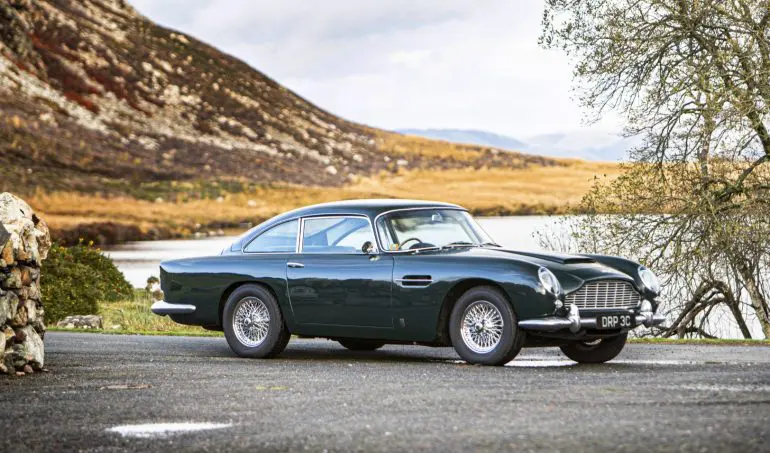The name’s Martin. Aston Martin. From the inception of the marque to today’s cutting-edge performance vehicles, the history of Aston Martin epitomises the ultimate in British elegance, refinement, and engineering prowess. The story of this world-renowned brand, purveyor of some of the most jaw-droppingly beautiful cars ever made, is a tale of the ages, marked by a timeline replete with innovation, iconic design, and, at times, profound challenges.
From humble beginnings, for many today Aston Martin stands out as a symbol of excellence, not merely for its cars but for an enduring commitment to exquisite quality which has made it a lasting emblem of luxury. Join us as we navigate the twists and turns of the Aston Martin car history, exploring the vehicles, the challenges, and the undeniable allure that have etched this legendary name in the pantheon of automotive history.
The Birth of a Legend

The original home of Aston Martin (Credit: Dan Kitwood/Getty Images)
Engineer Robert Bamford and businessman Lionel Martin founded Bamford & Martin Ltd in 1913, to sell and service cars made by early British manufacturers Singer, GWK and Calthorpe.
Within a year, the first car to bear the name Aston Martin was created by fitting a four-cylinder Coventry-Simplex engine to a 1908 Isotta Fraschini chassis. This car became colloquially known as the Coal Scuttle. The ‘Aston’ in Aston Martin was derived from Aston Martin founder Lionel Martin’s enthusiasm for racing at the Aston Hill Climb in Buckinghamshire.
By 1920, Robert Bamford had left the company and in 1922, the company built cars to compete at the French Grand Prix.
The Interwar Years: Trouble & Strife

Aston Martin Mk II (Credit: Sjoerd van der Wal via Getty Images)
In 1924 Aston Martin was bankrupt. The company went through a series of different owners – first Dorothea, Lady Charnwood, but after further financial difficulties, the company was sold to Bill Renwick and Augustus Bertelli. They revitalised the company and emphasised racing to boost the brand’s image.
By the start of the 1930s, the Aston Martin car history was almost over before it had begun. The Wall Street Crash of 1929 precipitated another bankruptcy in 1932. The company was bought by Sir Arthur Sutherland and the focus shifted from the track to the road. Around 700 cars were produced in the 1930s, including a 1.5-litre sports car called the Aston Martin Le Mans.
With the onset of World War II, Aston Martin’s history took a further turn. The company redirected its attention to supporting the British military by making aircraft components and other machinery. As a result, car manufacturing was halted, and all available resources were committed to the war effort.
David Brown & The Rebirth of Aston Martin

David Brown (1904 - 1993) (Credit: McCabe/Express/Hulton Archive/Getty Images)
As the war was ending, British tractor maker David Brown noticed an advert in The Times offering a ‘High Class Motor Business’ for sale for £30,000. His purchase in 1947 for £20,500 signalled a renaissance for the company, characterised by growth, innovation, and the introduction of the famous DB series.
Soon after his purchase of Aston Martin, David Brown also bought a company called Lagonda, principally for their astonishingly good 2.6-litre engine designed by W.O. Bentley, perhaps the most famous name in British luxury motoring.
The combination of Lagonda’s engineering capabilities and Aston Martin’s design prowess would help define the company’s post-war success and iconic status. Indeed the Aston Martin DB history is one of the most alluring in the automotive world.
The DB Series

1965 Aston Martin DB5 (Credit: National Motor Museum/Heritage Images via Getty Images)
Immediately prior to David Brown’s acquisition, the company had a 2-litre four cylinder prototype in design called the Atom. After a series of modifications, the Aston Martin 2-Litre Sports debuted at the 1948 London Motor Show and soon after entered production. It was retrospectively called the DB1.
In the twenty-two years between 1950 and 1972, the history of Aston Martin cars was at its zenith and each car was more beautiful than the last. The DB2, a 2.6-litre straight-six grand tourer, was launched in 1950, and three years later, the DB2/4 entered the market to critical acclaim.
Further iterations of the DB2/4 followed but they were the warm-up act for the sensational Carrozzeria-designed 3.7-litre Aston Martin DB4. It was the first car in Aston Martin history to be built at the company’s factory in Newport Pagnell. The DB4 went through a number of variants, including the truly staggering DB4GT Zagato. Yet in 1963, Aston Martin went even further with the launch of a car that was so mesmerisingly beautiful, it stopped the automotive world in its tracks.
Aston Martin DB5
The Aston Martin DB5, crafted by Italian coachbuilder Carrozzeria Touring Superleggera, was a paragon of luxury and performance. Equipped with a 4.0-litre, straight-six engine, it boasted 282 bhp, a top speed of 142 mph, and a 0-60 time of just 7.1 seconds.
The saloon was priced at £4,175, while the convertible came at £4,490. Notably, it also holds the record as the best-selling Corgi model ever. However, mere numbers and specifications can hardly encapsulate the full allure of the DB5.
Its beauty is inarguable and its fame is unparalleled. Beyond its celebrated connection to James Bond, the DB5 defined the sophisticated style of Sixties Britain. It’s more than hyperbole to assert that the modern history of Aston Martin inherits its design legacy from the DB5, with its graceful curves, sweeping bonnet, subtle badging, and side vents, all complemented by an ineffable sense of style and desirability that continues unabated today.
From Fame to Failure to Fame Again

Aston Martin DB6 (Credit: REBECCA NADEN/POOL/AFP via Getty Images)
Two more grand tourers followed – the DB6 and the DBS – but in 1972, Aston Martin was again beset by financial troubles. David Brown sold the company in 1972. In the wake of the global oil crisis, the new owners struggled to meet America’s new, stricter emissions requirements so US sales stopped and the company was sold again in 1975.
Following a successful revival strategy, Aston Martin unveiled the V8 Vantage in 1977, followed by the Volante in 1978.
The corporate landscape continued to shift in the 1980s, culminating in Ford taking a stake in the company. Under the chairmanship of Walter Hayes, another key turning point in the history of Aston Martin was marked by the development of a new and innovative model, further solidifying its commitment to excellence and innovation.
Strength to Strength - the Modern History of Aston Martin

The 2002 Aston Martin Vanquish (Credit: Finnbarr Webster/Getty Images)
Known as the first of the modern Astons, the DB7 launched in 1993 and the DB9, still an exquisite-looking car, made its debut in 2003.
In recent years, the company has launched a series of widely acclaimed supercars including the 5.9-litre DBS V12, the four-door Rapide, Aston’s most powerful V12 in the Vanquish, the 5.2-litre twin-turbocharged DB11, and the otherworldly Valkyrie, an electric hybrid producing a barely-believable 1,139 hp.
One of the most common questions asked about Aston Martin car history is why there was never a DB10, in between the DB9 and the DB11. In fact there was a DB10, but only ten were made and they were for the exclusive use of James Bond in the 2015 film Spectre.
Driving into the Future: Aston Martin’s Enduring Legacy

Aston Martin logo (Credit: Artur Widak/NurPhoto via Getty Images)
From the inauspicious beginnings of the Coal Scuttle to the sleek and sophisticated machines of the modern era, the history of Aston Martin is a compelling saga of innovation, resilience, and unparalleled elegance. The trials of the 70s and 80s, marked by corporate buyouts and strategic shifts, have only added to the marque’s mystique, cementing its status as a symbol of British automotive excellence.
The legacy and history of Aston Martin is not just found in the numbers, specs, or even the iconic DB series. It’s in the design ethos, the pursuit of perfection, and the relentless commitment to combine performance with luxury. Whether through the groundbreaking V8 Vantage or the timeless allure of the DB5, Aston Martin has consistently proven that cars are more than just a means of getting from one place to another; they can be works of art and objects of desire.
As the marque looks to the future, it continues to embody the spirit of innovation that has defined Aston Martin’s history. With an unwavering focus on craftsmanship and style, Aston Martin stands as a beacon of British sophistication and a promise of what the epitome of automotive elegance can be.













